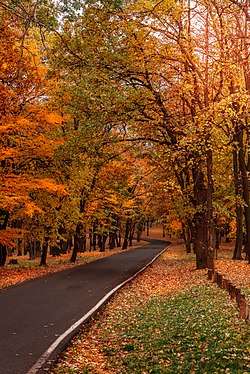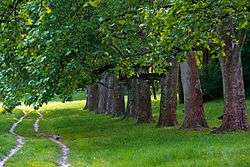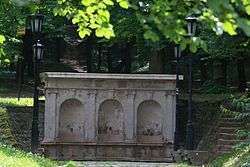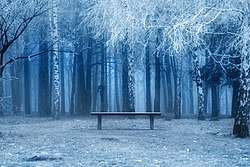Košutnjak
| Košutnjak | |
|---|---|
| Кошутњак | |
 Autumn in Košutnjak | |
 Location within Belgrade | |
| Location | Rakovica, Belgrade |
| Coordinates | 44°46′00″N 20°26′06″E / 44.76667°N 20.43500°ECoordinates: 44°46′00″N 20°26′06″E / 44.76667°N 20.43500°E |
| Open | Open all year |
Košutnjak (Serbian Cyrillic: Кошутњак, pronounced [kǒʃutɲaːk]) is a park-forest and urban neighborhood of Belgrade, the capital of Serbia. It is divided between in the municipalities of Čukarica (upper and central parts) and Rakovica (lower part). With the adjoining Topčider, it is colloquially styled "Belgrade's oxygen factory".[1]
Etymology
The name, košutnjak, is derived from the medieval hunting forests of the Serbian nobility, meaning doe's breeder. (In Serbian, košuta means doe, hind), as does used to live freely in the park until the World War I. The name was mentioned for the first time in 1831.[2]
Geography
The Košutnjak hill is 250 m (820 ft) high and the entire forest complex covers an area of 330 ha (820 acres).[3]
Košutanjak has a few geological natural monuments. They include several Cretaceous maritime ridges of "Burdelj", "Tasin Majdan" and "Baremski", on the location of the assassination of the prince Michael, and a geology profile where the mint is located today.[4]
Location
Košutnjak is located 6 km southwest from the downtown Belgrade. It is bordered by the neighborhoods of Topčider to the north and west, Kanarevo Brdo to the northwest, Rakovica and Skojevsko Naselje to the south, and Žarkovo (with its extensions of Cerak, Cerak II, Repište) and Banovo Brdo (with its extension of Sunčana Padina) to the east. Filmski Grad (to the southwest) and Golf Naselje (to the northwest) are sub-neighborhoods of Košutnjak.

History


In the 19th century, Košutnjak was a fenced hunting ground and royal excursion place for the members of the Obrenović dynasty. Until the World War I, the area was under quality oak forest. A document from 1849 says that there were 48 deers in Košutnjak, 13 bulls and 35 does. In 1884 the first railway in Serbia, which connected Belgrade and Niš, was constructed through the forest. In 1908 Belgian architect Alban Chambon drafted a new general urban plan (GUP) in 1908 which made Košutnjak a public park.[1]
Košutnjak gained a sort of historical notoriety as prince of Serbia, Mihailo Obrenović III and his cousin Anka Konstantinmović were assassinated while walking in the park on 10 June [O.S. 29 May] 1869, and when Ivan Stambolić, Slobodan Milošević's political opponent was abducted from the park on 25 August 2000 and later assassinated and buried at Fruška Gora. There are also remnants of the German cemetery and the monuments to the Serbian soldiers erected by their adversaries, German soldiers, in World War I.[1]
Until World War II, the pheasants were abundant too and in this period Košutnjak was a healing destination for many city children. After 1945 city urbanists considered the way Topčider-Košutnjak complex has been handled was wrong, especially the expansion of the railway station into the marshalling yard and construction of Filmski Grad (both especially hurt Košutnjak's appeal), so the Belgrade's GUP in the 1950s projected the complete removal of the railway objects from the Topčider valley, but that was never executed.
In 1922 company "Čavlina and Sladoljev" from Zagreb drafted the project of connecting two banks of the Sava river by the cable car. In 1928, building company "Šumadija" again proposed the construction of the cable car, which they called "air tram" but this project was planned to connect Zemun to Kalemegdan on Belgrade Fortress, via Great War Island. The interval of the cabins was set at 2 minutes and the entire route was supposed to last 5 minutes. The project was never realized. Engineer and CEO of the Yugoslav institute for urbanism and dwelling "Juginus", Mirko Radovanac, revived the idea in the 1990s. After conducting extensive surveys (traffic analysis, interviews with the commuters, climatic, geological, urban and other researches), "Juginus" presented the project in 1993. They proposed that the termini should be at the Sports Center Košutnjak and Block 44 in the neighborhood of Savski Blokovi in New Belgrade, across the Sava. Stops in between would include the major public transportation roundabout in Banovo Brdo, Makiš and Ada Ciganlija, five in total. They called it the "ideal route". The plan also included construction of commercial areas around the termini, which would cover 2,000 m2 (22,000 sq ft) and help with the profitability of the project. Apart from being ecological and an attraction, it was estimated that it would shorten the trip for 45 minutes. City government included the project into the city's GUP, which envisioned the construction in phases, the first being a 1,000 m (3,300 ft) long section Block 44-Ada Ciganlija. It would lay on 8 steel pillars, 35 m (115 ft) above the ground and the trip would last for 3 minutes. The cabins were projected to receive not just the commuters, but also the bicycles, skateboards, sledges and skis, as the cableway was planned to work year-round. The complete facility would have 27 pillars; it would be 5 km (3.1 mi) long which would be travelled in 15 minutes by 2,000 commuters per hour.[5] Despite the project being publicly revived by the mayors Dragan Đilas (2008–13) and Siniša Mali (since 2013), as of 2017 the project still hasn't started.
Wildlife
Plants
Košutnjak is home to many plant and animal species, some of which are under strict protection. There are 521 plant species, including lime tree, pedunculate oak, common hornbeam, Turkey oak, Hungarian oak, European yew, sweet chestnut, cherry laurel, hackberry and Turkish hazel. About 5% of the forest is inhabited by the conifers, mostly cedar, black pine and white pine. In 2015, an average age of the trees has been estimated to 60–70 years. Also in 2015, about 50 ha (120 acres) of Košutnjak has been re-forested with 4,400 seedlings of the common ash and sycamore.[1]
Animals
Animals inhabiting the forest are squirrels, hedgehogs, woodpeckers and bats.[1]
Importance
Košutnjak is one of the most popular recreational places in Belgrade. With 40 ha (99 acres), Sports Center Košutnjak is one of the largest and most diverse in the city (stadiums, pools, etc.),[6] while the park also has an auto-camp, modern settlements of Filmski Grad and Pionirski Grad, big studios of the national broadcaster Radio Television of Serbia, many popular restaurants and arranged paths criss-crossing the forest. There are also jogging tracks and a ski run.
In the lower parts, Košutnjak and Topčider forests grew together, while in the upper parts they are divided by the river Topčiderska reka and a railway passing through the river's valley (both Košutnjak and Topčider have their own, separate train stations).
Nobelist author Ivo Andrić wrote: "You just hang on to Topčider and Košutnjak...Topčider is my favorite place, where I ate bread and drank wine in the sweetest and calmest manner". Andrić's longtme friend, painter Leposava Bela Pavlović, made two paintings of Košutnjak in 1943. One, titled "Košutnjak, 1943" just shows the nature and is today exhibited in the Memorial museum of Ivo Andrić. On the another one, "In Košutnjak during the occupation" she painted Andrić, Milica Babić-Jovanović (Andrić's future wife) and Nenad Jovanović. This painting is in the National Museum of Serbia.[7]
Hajdučka česma (Hajduks' drinking fountain) is a natural spring, which is one of the most prominent destinations for the picnickers, especially as the most popular location of the traditional Prvomajski uranak ("Labour Day early outing"), celebration of May 1, Labour Day, in Belgrade. On 28 August 1977 a spectacular concert of the rock group Bijelo Dugme was held. With an attendance of over 100,000, it is considered as one of the seminal events in the history of Yugoslav rock.[1]
Protection
In 2014, city government declared "Košutnjak Forest" as a protected area, or the nature monument. Protected locality covers an area of 265.26 ha (655.5 acres).[1] Košutnjak is the natural reserve of pedunculate oak, common hornbeam and silver lime.[2]
Arboretum
New building of the Faculty of forestry was built in 1956, right above Careva Ćuprija, where the northwest section of the vast wood of Košutnjak begins at an altitude of 110–125 meters. Professors and students began developing a dendrology collection in 1957, which grew into the Arboretum of the Faculty of Forestry, a specific botanical garden which was protected by the state in July 2011 as the natural monument. It is used as an open-air classroom, for the practical studies of the students but also by the scientist for their work. The arboretum has its nursery garden and the greenhouse. On 6.7 hecaters, the arboretum holds 2,000 individual specimen of 300 trees and shrubs. They include 218 deciduous and 24 conifer species, out of which 80 are ornamental, and 40 species of the perennial plants. There are 77 domestic and 146 foreign species, including: narrow-leafed ash, Balkan maple, Balkan forsythia, laburnum, giant sequoia, cedar, cherry laurel (new variety developed in arboretum), Himalayan pine and the oldest metasequoia in Belgrade.[8][9][10]
Sub-neighborhoods
Golf
Filmski Grad
Pionirski Grad
Pionirski Grad (Serbian: Пионирски град, pronounced [piǒniːrskiː ɡrâːd]) is a sub-neighborhood of Košutnjak, in its south-central section, which belongs to the municipality of Rakovica. It is a small weekend-settlement, without permanent population, just west of the neighborhood of Filmski Grad. The name, pionirski grad in Serbian means "pioneer's town".
First objects were built during the period of German occupation in World War II. An anti-aircraft unit of Luftwaffe was placed in the area in 1943. The soldiers built small houses in Alpine style on the glades, with typical cornices and Bavarian windows. In the surrounding area they dug numerous underground bunkers which are today decaying and are mostly covered with overgrowth. Those which are outside of the woods are occasionally rediscovered during construction works. After the war, architect Ratko Tatić developed the settlement.[11]
Pionirski Grad covers an area of 36.5 ha (90 acres) and is a non-residential settlement completely surrounded by the woods of Košutnjak. There are 9 pavilions with a total area of 200 m2 (2,200 sq ft). They were organized as the Pionirski Grad in 1947 and, as the name says, were intended to be the children’s recreational center. Objects in the settlement include restaurant “Ozon”, two bungalows which serve as the kindergarten and outdoor terrains for basketball, futsal, handball, tennis, athletics and jogging. In the concrete hall there are indoor courts for futsal and squash, the first and only in Belgrade. Major building has an area of 6,000 m2 (65,000 sq ft) and contains restaurant, cabinets, classrooms, disco and artistic ateliers. Within the building there is also an amphitheatre with 600 seats which was rented for the Veliki Brat, Serbian version of the reality show Big Brother, talent show Operacija Trijumf and for the “I love Serbia” quiz show, Serbian version of the I Love My Country. In its heyday Pionirski Grad had an attendance of 100,000 per year but it lost its recreational function when the refugees from the Yugoslav Wars were settled in seven pavilions from the 1990s to 2010s. The complex was partially renovated in the early 2010s: street lights were repaired, green areas rearranged and memorial plaques placed.[12][13] A process of step-by-step reconstruction began in 2014. By 2017 the hall and the sports terrains have been renovated, the house of "Big Brother" was demolished and all objects have been vacated awaiting the reconstruction in 2018. Number of children visiting the premises during the year grew to 12,000 in 2016.[14]
References
- 1 2 3 4 5 6 7 Branka Vasiljević (23 March 2015). "Čišćenje pluća fabrike kiseonika" (in Serbian). Politika.
- 1 2 Milan Janković (27 April 2014), "Beogradske šume preživele i ratove", Politika (in Serbian)
- ↑ "Košutnjak", Politika (in Serbian), 31 July 2011
- ↑ Vladimir Vukasović (9 June 2013), "Prestonica dobija još devet prirodnih dobara", Politika (in Serbian)
- ↑ Dejan Spalović (27 August 2012), "San o žičari od Bloka 44 do Košutnjaka", Politika (in Serbian)
- ↑ Branka Vasiljević (3 December 2012), "Građani spremni da uređuju Košutnjak", Politika (in Serbian)
- ↑ Biljana Đorđević Mironja (21 July 2018). "Андрићев ратни излет" [Andrić's war picnic]. Politika-Kulturni dodatak, year LXII, No. 15 (in Serbian). p. 01.
- ↑ Milan Janković (March 2014), "Skriveni svet drveća i bilja", Politika (in Serbian)
- ↑ "Arboretum Šumarskog fakulteta – urbana oaza" (in Serbian). Beoinfo. 28 July 2013.
- ↑ Branka Vasiljević (2011), "Botanička bašta u Košutnjaku postala zaštićeno dobro", Politika (in Serbian)
- ↑ Bane Gajić (20 October 2016). "Šta su sve izgradili nacisti u Beogradu" [What was built in Belgrade by the Nazis] (in Serbian). Vice.
- ↑ Marija Brakočević, "Zaboravljeni Pionirski grad", Politika (in Serbian)
- ↑ Daliborka Mučibabić (2009), "Oaza u Košutnjaku opet pripada deci", Politika (in Serbian)
- ↑ A.J. (23 August 2017), "U Pionirskom gradu ponovo - deca", Politika (in Serbian), p. 15
External links
| Wikimedia Commons has media related to Košutnjak. |